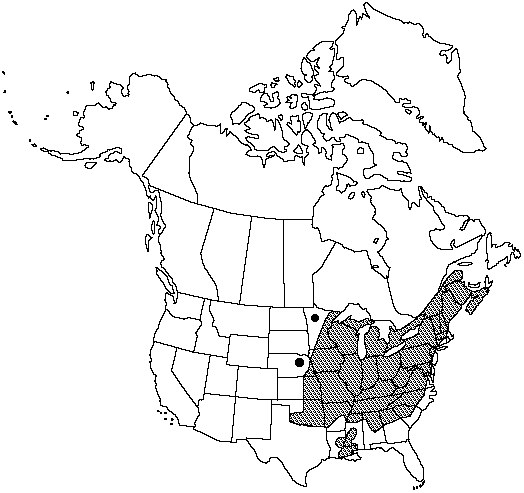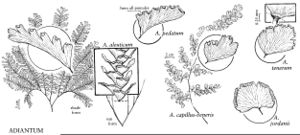Difference between revisions of "Adiantum pedatum"
Sp. Pl. 2: 1095. 1753.
FNA>Volume Importer |
FNA>Volume Importer |
||
| Line 23: | Line 23: | ||
}}<!-- | }}<!-- | ||
| − | --><span class="statement" id="st- | + | --><span class="statement" id="st-undefined" data-properties=""><b>Stems </b>short-creeping; scales bronzy deep yellow, concolored, margins entire. <b>Leaves</b> lax-arching (rarely pendent), closely spaced, 40–75 cm. <b>Petiole</b> 1–2 mm diam., glabrous, occasionally glaucous. <b>Blade</b> fan-shaped, pseudopedate, 1-pinnate distally, 15–30 × 15–35 cm, glabrous; proximal pinnae 3–9-pinnate; rachis straight, glabrous, occasionally glaucous. <b>Segment</b> stalks 0.5–1.5(–1.7) mm, dark color entering into segment base. <b>Ultimate</b> segments oblong, ca. 3 times as long as broad; basiscopic margin straight; acroscopic margin lobed, lobes separated by narrow incisions 0–0.9(–1.1) mm wide; apex obtuse, divided into shallow, rounded lobes separated by shallow sinuses 0.1–2(–3.7) mm deep, margins of lobes crenulate or crenate-denticulate. <b>Indusia</b> transversely oblong, 1–3 mm, glabrous. <b>Spores</b> mostly 34–40 µm diam. <b>2n</b> = 58.</span><!-- |
-->{{Treatment/Body | -->{{Treatment/Body | ||
| + | |phenology=Sporulating summer–fall. | ||
|habitat=Rich, deciduous woodlands, often on humus-covered talus slopes and moist lime soils | |habitat=Rich, deciduous woodlands, often on humus-covered talus slopes and moist lime soils | ||
|elevation=0–700 m | |elevation=0–700 m | ||
| Line 45: | Line 46: | ||
|basionyms= | |basionyms= | ||
|family=Pteridaceae | |family=Pteridaceae | ||
| + | |phenology=Sporulating summer–fall. | ||
|habitat=Rich, deciduous woodlands, often on humus-covered talus slopes and moist lime soils | |habitat=Rich, deciduous woodlands, often on humus-covered talus slopes and moist lime soils | ||
|elevation=0–700 m | |elevation=0–700 m | ||
| Line 52: | Line 54: | ||
|publication year=1753 | |publication year=1753 | ||
|special status= | |special status= | ||
| − | |source xml=https://jpend@bitbucket.org/aafc-mbb/fna- | + | |source xml=https://jpend@bitbucket.org/aafc-mbb/fna-data-curation.git/src/9216fc802291cd3df363fd52122300479582ede7/coarse_grained_fna_xml/V2/V2_74.xml |
|genus=Adiantum | |genus=Adiantum | ||
|species=Adiantum pedatum | |species=Adiantum pedatum | ||
| − | |||
| − | |||
| − | |||
| − | |||
| − | |||
| − | |||
| − | |||
| − | |||
| − | |||
| − | |||
| − | |||
| − | |||
| − | |||
| − | |||
| − | |||
| − | |||
| − | |||
| − | |||
| − | |||
| − | |||
| − | |||
| − | |||
| − | |||
| − | |||
| − | |||
| − | |||
| − | |||
| − | |||
| − | |||
| − | |||
| − | |||
| − | |||
| − | |||
| − | |||
| − | |||
| − | |||
| − | |||
| − | |||
| − | |||
| − | |||
| − | |||
}}<!-- | }}<!-- | ||
-->[[Category:Treatment]][[Category:Adiantum]] | -->[[Category:Treatment]][[Category:Adiantum]] | ||
Revision as of 13:27, 27 July 2019
Stems short-creeping; scales bronzy deep yellow, concolored, margins entire. Leaves lax-arching (rarely pendent), closely spaced, 40–75 cm. Petiole 1–2 mm diam., glabrous, occasionally glaucous. Blade fan-shaped, pseudopedate, 1-pinnate distally, 15–30 × 15–35 cm, glabrous; proximal pinnae 3–9-pinnate; rachis straight, glabrous, occasionally glaucous. Segment stalks 0.5–1.5(–1.7) mm, dark color entering into segment base. Ultimate segments oblong, ca. 3 times as long as broad; basiscopic margin straight; acroscopic margin lobed, lobes separated by narrow incisions 0–0.9(–1.1) mm wide; apex obtuse, divided into shallow, rounded lobes separated by shallow sinuses 0.1–2(–3.7) mm deep, margins of lobes crenulate or crenate-denticulate. Indusia transversely oblong, 1–3 mm, glabrous. Spores mostly 34–40 µm diam. 2n = 58.
Phenology: Sporulating summer–fall.
Habitat: Rich, deciduous woodlands, often on humus-covered talus slopes and moist lime soils
Elevation: 0–700 m
Distribution

N.B., N.S., Ont., Que., Ala., Ark., Conn., Del., D.C., Ga., Ill., Ind., Iowa, Kans., Ky., La., Maine, Md., Mass., Mich., Minn., Miss., Mo., Nebr., N.H., N.J., N.Y., N.C., Ohio, Okla., Pa., R.I., S.C., Tenn., Vt., Va., W.Va., Wis.
Discussion
Once considered a single species across its range in North America and eastern Asia, Adiantum pedatum is considered to be a complex of at least three vicariant species (A. pedatum and A. aleuticum occur in North America) and a derivative allopolyploid species (C. A. Paris 1991). Adiantum pedatum in the strict sense is restricted to deciduous woodlands in eastern North America.
Selected References
None.
